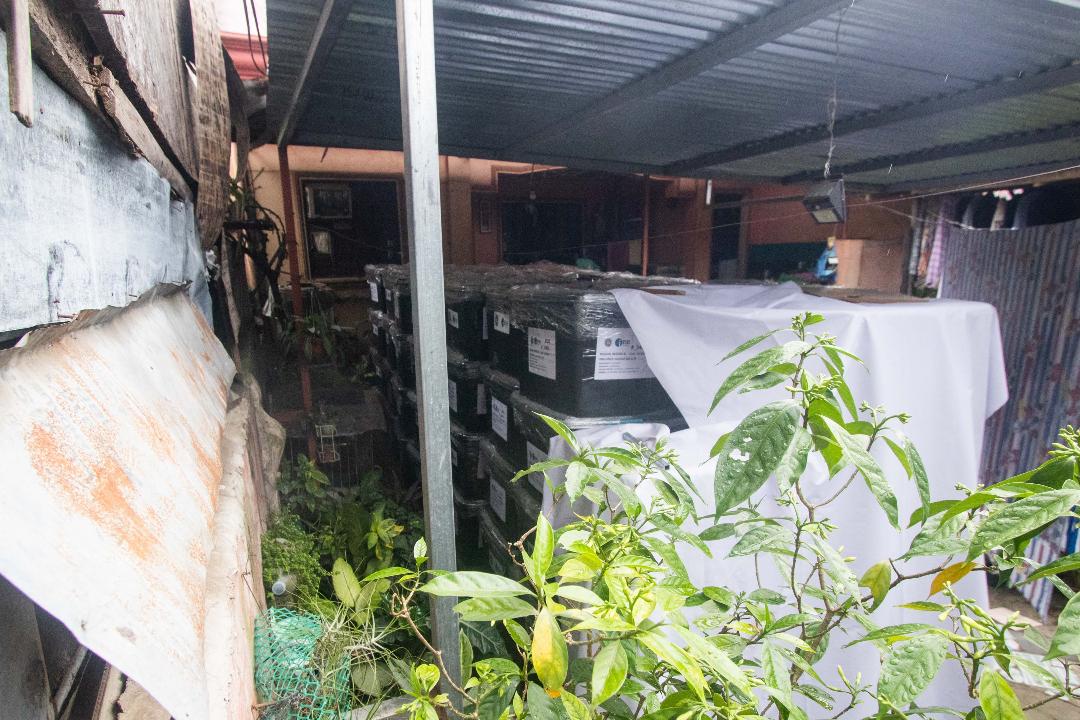Davao City folk fear electoral fraud after discovery of equipment at house
DAVAO CITY – The discovery of dozens of election paraphernalia in a private residence in Barangay Buhangin here has sparked concerns of electoral fraud from different sectors.

ELECTION paraphernalia stored in a residential area on Saturday, April 5. (Keith Bacongco)
Rumors circulated on social media on Friday night, April 4, that alleged election paraphernalia were stored in a privately owned compound in the densely populated area of Barangay Buhangin.
On Saturday, April 5, the Davao City Police Office confirmed that initial investigation by the Buhangin Police Station bared that the owner of the residential compound confirmed that these boxes contained solar panels and Wi-Fi transmission equipment from Commission on Elections-Manila intended for distribution to towns in the Davao region.
The DCPO verified the report after a barangay official reported to the police the presence of election paraphernalia in the residential area.
Police added that the equipment was part of the transmission devices provided by Comelec’s transmission service provider, iOne Resources Joint Venture with Ardent Networks Inc. (iOne V).
As the pictures of what appear to be dozens of boxes of election paraphernalia circulated on social media on Saturday morning, residents here raised concerns why the equipment were stored in a non-secured facility.
The United Moro and Indigenous People Movement (UMIPM) is alarmed over the discovery.
“As an organization committed to the promotion of fair, honest, and transparent elections, we view this incident as a serious threat to the integrity of the democratic process. The unexplained presence of sensitive electoral equipment in a non-official, unsecured location raises red flags and justifiable fears of possible manipulation or electoral fraud,” UMIPM said.
They added that Indigenous Peoples and Muslims have long struggled for equal voice, representation, and dignity within the political system. “The sanctity of our votes must never be compromised. Any indication of irregularities – especially involving technology that may be used in election transmission – must be met with swift, thorough, and impartial investigation.”
The transmission devices were stored in the residential compound with an area of about 200-square meters. Some of the plastic boxes, which contained the devices, were kept inside a residential house while some were stacked outside the houses under a makeshift roof.
Even though some of the boxes were covered with plastic material, some were still visible from the narrow alley leading to one of the gates of the compound.
According to reports, there were at least 300 transmission kits stored in the compound.
One of the residents living near the compound said that the election paraphernalia should have been stored in a more secured location, like a warehouse, and not in a residential compound.
He added that they were also surprised to learn that vital election equipment was just stored in a populated area without police presence.
Sources said that the transmission devices arrived in the area on March 30. But one of the residents living inside the compound told reporters that the equipment arrived on April 2.
On Saturday afternoon, the Comelec confirmed in a statement that the residential compound was part of the contractor’s temporary storage hub after these were taken from the poll body’s warehouse.
IOne JV confirmed that the residential compound is one of their staging hubs and Comelec also said that they have a list of all temporary staging hubs and storage areas of iOne JV and Barangay Buhangin.
But on the same day, the Field Operations Group led by Deputy Executive Director Rafael B. Olaño ordered iOne JV to remove the Starlink devices and solar panels from Davao City and bring them directly to their Office of the Election Officers under the supervision of Comelec employees and the Philippine National Police for added security and transparency.
On Sunday, April 6, the transmission devices were hauled to Tagum City in Davao del Norte. However, the equipment was returned to this city on Monday morning.
The Comelec said that they found no irregularity in the incident.
“This is no election program or software that will affect the use of the Automated Counting Machines and Consolidation and Canvassing Systems, as well as the entire Election Management System,” the Comelec said.